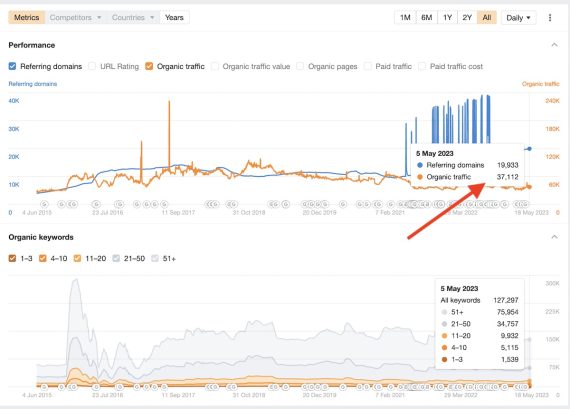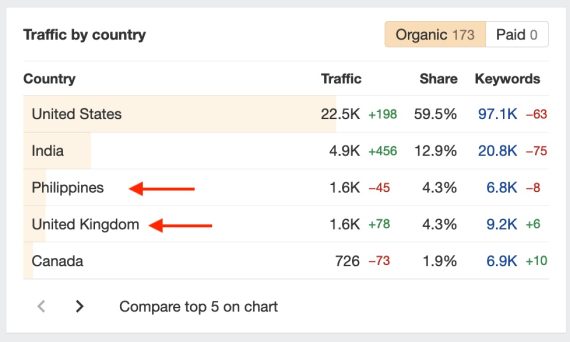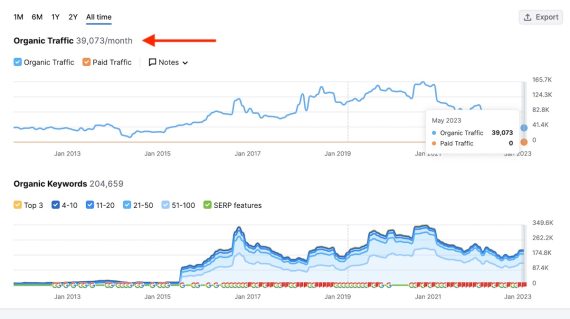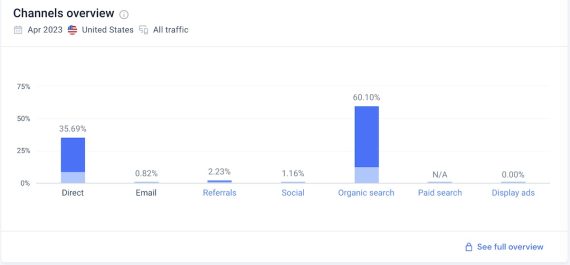Analyzing the traffic on your own website is straightforward with Google Analytics and Search Console. But analyzing traffic on third-party sites requires external tools.
I’ll compare three of those tools in this post.
To test, I will use a client’s website since I can access actual data. The site generates roughly 100,000 monthly sessions from various sources. Organic search traffic is about 80,000 monthly sessions — roughly 75,000 from Google.
Ahrefs: Google Organic and Paid
Ahrefs estimates traffic from Google search — organic and paid — on any website based on the tool’s internal rankings assessment. It includes a graph that attempts to approximate that traffic over time.
You can easily match traffic and ranking fluctuations by hovering over the dates in the graph. Ahrefs estimates my website’s monthly traffic (as of May 2023) at 37,112 sessions, more than 50% lower than the actual.
Ahrefs assesses a site’s organic traffic over time, showing volume and fluctuations. The traffic estimate of the author’s site was roughly 50% too low. Click image to enlarge.
You can also see your visitors’ countries. This chart was more or less accurate, with one exception. According to Google Analytics, the third most popular country was United Kingdon, with Phillippines following it.
Ahrefs reports traffic by country, although the author’s site has more traffic from the U.K. traffic than the Philippines. Click image to enlarge.
Pricing for Ahrefs starts at $99 per month. Advanced analyses (such as top pages by organic clicks) require the $199-per-month version or higher. Ahrefs offers no free trial.
Semrush: Google Organic and Paid
Semrush provides similar data as Ahrefs based on its internal estimates of rankings. Correlating traffic and rankings in Semrush is, to me, not as easy as in Ahrefs, but the output is almost the same. Semrush reported my monthly traffic at 39,073 sessions which, like Ahrefs, is wildly incorrect.
Semrush estimates a site’s monthly traffic from Google organic search. Click image to enlarge.
Semrush also inaccurately placed the Philippines as the third most popular country. The tool’s ranking of my top pages by organic clicks was also wrong.
Semrush’s prices start at $120 per month with a 7-day free trial (credit card is required).
Similarweb: All Sources
I don’t have a Similarweb premium account. What follows is my evaluation based on the free trial.
Similarweb reports the overall traffic of any website from all channels, not just Google. The data comes from four sources, per Similarweb: partnerships, data from various websites, Similarweb’s apps and extensions installed on varied devices, and publicly available info. Those descriptions are vague, although I can understand why owing to competitive pressures.
Similarweb estimated monthly sessions at my site as 79,763 (again, the actual is about 100,000). Like Ahrefs and Semrush, Similarweb’s ranking of the top traffic-driving countries was inaccurate.
Similarweb’s estimate of my top traffic channels was close, although my actual referral traffic is much higher than 2.23%.
Similarweb’s estimate of the author’s top traffic channels was close, although the actual referral traffic is higher than 2.23%. Click image to enlarge.
The platform’s estimation of my top traffic-driving social network was wrong, as were the top referral sources. (I should add Google Analytics is wrong, too, as it shows email marketing traffic as a referral.) Similarweb was fairly close at identifying top traffic-driving search queries.
Overall, Similarweb offered useful data to compare websites, albeit with flaws. Using it in combination with Ahrefs or Semrush provides a more complete overview.
Similarweb offers a free 7-day trial but does not publish prices.
Helpful, not Perfect
My takeaways from Ahrefs’ and Similarweb’s organic traffic analysis:
- The tools’ estimations were surprisingly close. I see no reason to use both of them.
- Both appear to see about half of Google’s searches. That is a lot but understandable, as long-tail queries are unpredictable, and roughly 15% of all searches are new, per Google.
- The two tools agree on traffic trends, a very useful insight. Their traffic graphs include citations for Google updates to see the effect.
All three tools underestimated the actual traffic of my site but provided helpful data for competitive research.




